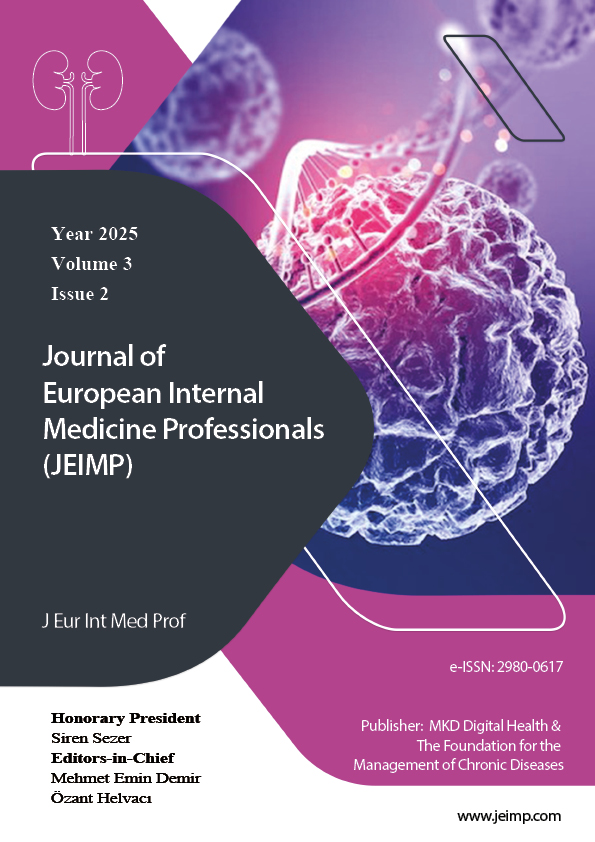Exploring The Role of Circulating Biomarkers in Glioblastoma Multiforme: Bridging The Gap Between Laboratory and Clinic
Exploring Circulating Biomarkers in GBM
DOI:
https://doi.org/10.5281/zenodo.15061495Keywords:
Glioblastoma Multiforme, Circulating Biomarkers, Liquid BiopsyAbstract
Glioblastoma multiforme is the most prevalent and aggressive primary malignant brain tumor in adults, characterized by significant intratumoral heterogeneity and resistance to conventional therapies. Despite improvements in surgical resection, radiotherapy, and chemotherapy with temozolomide, GBM remains incurable, with a median survival of 10–15 months. Current diagnostic modalities include magnetic resonance imaging and tissue biopsies, face early detection, real-time monitoring, and comprehensive tumor profiling limitations. These challenges underscore the urgent need for minimally invasive, highly specific, and sensitive diagnostic tools. Liquid biopsy has emerged as a promising alternative, enabling the detection of circulating biomarkers, including circulating tumor cells, cell-free nucleic acids, extracellular vesicles, and proteins from biofluids such as blood and cerebrospinal fluid. These biomarkers offer insights into tumor heterogeneity, therapeutic resistance, and progression while facilitating dynamic treatment response monitoring. This review explores the potential of circulating biomarkers in revolutionizing GBM diagnosis and management, focusing on their molecular characteristics, clinical utility, and limitations. By integrating these innovative approaches into clinical practice, liquid biopsy has the potential to significantly improve patient outcomes, heralding a new era in the diagnosis, prognosis, and therapeutic monitoring of GBM.
References
Kanderi T, Munakomi S, Gupta V. Glioblastoma Multiforme. In: StatPearls. Treasure Island (FL): StatPearls Publishing; May 6, 2024.
Grochans S, Cybulska AM, Simińska D, et al. Epidemiology of Glioblastoma Multiforme-Literature Review. Cancers (Basel). 2022;14(10):2412. Published 2022 May 13. doi:10.3390/cancers14102412
Aldoghachi AF, Aldoghachi AF, Breyne K, Ling KH, Cheah PS. Recent Advances in the Therapeutic Strategies of Glioblastoma Multiforme. Neuroscience. 2022;491:240-270. doi:10.1016/j.neuroscience.2022.03.030
Hanif F, Muzaffar K, Perveen K, Malhi SM, Simjee ShU. Glioblastoma Multiforme: A Review of its Epidemiology and Pathogenesis through Clinical Presentation and Treatment. Asian Pac J Cancer Prev. 2017;18(1):3-9. Published 2017 Jan 1. doi:10.22034/APJCP.2017.18.1.3
Ronvaux L, Riva M, Coosemans A, et al. Liquid Biopsy in Glioblastoma. Cancers (Basel). 2022;14(14):3394. Published 2022 Jul 13. doi:10.3390/cancers14143394
Jelski W, Mroczko B. Molecular and Circulating Biomarkers of Brain Tumors. Int J Mol Sci. 2021;22(13):7039. Published 2021 Jun 29. doi:10.3390/ijms22137039
Müller Bark J, Kulasinghe A, Chua B, Day BW, Punyadeera C. Circulating biomarkers in patients with glioblastoma. Br J Cancer. 2020;122(3):295-305. doi:10.1038/s41416-019-0603-6
Taylor OG, Brzozowski JS, Skelding KA. Glioblastoma Multiforme: An Overview of Emerging Therapeutic Targets. Front Oncol. 2019;9:963. Published 2019 Sep 26. doi:10.3389/fonc.2019.00963
Rincon-Torroella J, Khela H, Bettegowda A, Bettegowda C. Biomarkers and focused ultrasound: the future of liquid biopsy for brain tumor patients. J Neurooncol. 2022;156(1):33-48. doi:10.1007/s11060-021-03837-0
Stupp R, Mason WP, van den Bent MJ, et al. Radiotherapy plus concomitant and adjuvant temozolomide for glioblastoma. N Engl J Med. 2005;352(10):987-996. doi:10.1056/NEJMoa043330
Wu W, Klockow JL, Zhang M, et al. Glioblastoma multiforme (GBM): An overview of current therapies and mechanisms of resistance. Pharmacol Res. 2021;171:105780. doi:10.1016/j.phrs.2021.105780
Klekner Á, Szivos L, Virga J, et al. Significance of liquid biopsy in glioblastoma - A review. J Biotechnol. 2019;298:82-87. doi:10.1016/j.jbiotec.2019.04.011
Delgado-López PD, Riñones-Mena E, Corrales-García EM. Treatment-related changes in glioblastoma: a review on the controversies in response assessment criteria and the concepts of true progression, pseudoprogression, pseudoresponse and radionecrosis. Clin Transl Oncol. 2018;20(8):939-953. doi:10.1007/s12094-017-1816-x
Senhaji N, Squalli Houssaini A, Lamrabet S, Louati S, Bennis S. Molecular and Circulating Biomarkers in Patients with Glioblastoma. Int J Mol Sci. 2022;23(13):7474. Published 2022 Jul 5. doi:10.3390/ijms23137474
McDonald KL, Aw G, Kleihues P. Role of Biomarkers in the Clinical Management of Glioblastomas: What are the Barriers and How Can We Overcome Them?. Front Neurol. 2013;3:188. Published 2013 Jan 18. doi:10.3389/fneur.2012.00188
Eibl RH, Schneemann M. Liquid biopsy and glioblastoma. Explor Target Antitumor Ther. 2023;4(1):28-41. doi:10.37349/etat.2023.00121
Gatto L, Franceschi E, Di Nunno V, Tosoni A, Lodi R, Brandes AA. Liquid Biopsy in Glioblastoma Management: From Current Research to Future Perspectives. Oncologist. 2021;26(10):865-878. doi:10.1002/onco.13858
Linhares P, Carvalho B, Vaz R, Costa BM. Glioblastoma: Is There Any Blood Biomarker with True Clinical Relevance?. Int J Mol Sci. 2020;21(16):5809. Published 2020 Aug 13. doi:10.3390/ijms21165809
Seyhan AA. Circulating Liquid Biopsy Biomarkers in Glioblastoma: Advances and Challenges. Int J Mol Sci. 2024;25(14):7974. Published 2024 Jul 21. doi:10.3390/ijms25147974
Saenz-Antoñanzas A, Auzmendi-Iriarte J, Carrasco-Garcia E, et al. Liquid Biopsy in Glioblastoma: Opportunities, Applications and Challenges. Cancers (Basel). 2019;11(7):950. Published 2019 Jul 5. doi:10.3390/cancers11070950
Khristov V, Lin A, Freedman Z, et al. Tumor-Derived Biomarkers in Liquid Biopsy of Glioblastoma. World Neurosurg. 2023;170:182-194. doi:10.1016/j.wneu.2022.11.012
Birkó Z, Nagy B, Klekner Á, Virga J. Novel Molecular Markers in Glioblastoma-Benefits of Liquid Biopsy. Int J Mol Sci. 2020;21(20):7522. Published 2020 Oct 12. doi:10.3390/ijms21207522
Haber DA, Velculescu VE. Blood-based analyses of cancer: circulating tumor cells and circulating tumor DNA. Cancer Discov. 2014;4(6):650-661. doi:10.1158/2159-8290.CD-13-1014
Trivedi R, Bhat KP. Liquid biopsy: creating opportunities in brain space. Br J Cancer. 2023;129(11):1727-1746. doi:10.1038/s41416-023-02446-0
Massagué J, Obenauf AC. Metastatic colonization by circulating tumour cells. Nature. 2016;529(7586):298-306. doi:10.1038/nature17038
Jones J, Nguyen H, Drummond K, Morokoff A. Circulating Biomarkers for Glioma: A Review. Neurosurgery. 2021;88(3):E221-E230. doi:10.1093/neuros/nyaa540
Müller C, Holtschmidt J, Auer M, et al. Hematogenous dissemination of glioblastoma multiforme. Sci Transl Med. 2014;6(247):247ra101. doi:10.1126/scitranslmed.3009095
Cabel L, Proudhon C, Gortais H, et al. Circulating tumor cells: clinical validity and utility. Int J Clin Oncol. 2017;22(3):421-430. doi:10.1007/s10147-017-1105-2
Gao F, Cui Y, Jiang H, et al. Circulating tumor cell is a common property of brain glioma and promotes the monitoring system. Oncotarget. 2016;7(44):71330-71340. doi:10.18632/oncotarget.11114
Macarthur KM, Kao GD, Chandrasekaran S, et al. Detection of brain tumor cells in the peripheral blood by a telomerase promoter-based assay. Cancer Res. 2014;74(8):2152-2159. doi:10.1158/0008-5472.CAN-13-0813
Gao F, Zhao W, Li M, et al. Role of circulating tumor cell detection in differentiating tumor recurrence from treatment necrosis of brain gliomas. Biosci Trends. 2021;15(2):107-117. doi:10.5582/bst.2021.01017
Sullivan JP, Nahed BV, Madden MW, et al. Brain tumor cells in circulation are enriched for mesenchymal gene expression. Cancer Discov. 2014;4(11):1299-1309. doi:10.1158/2159-8290.CD-14-0471
Chen J, Luo Y, Xi X, et al. Circulating tumor cell associated white blood cell cluster as a biomarker for metastasis and recurrence in hepatocellular carcinoma. Front Oncol. 2022;12:931140. Published 2022 Nov 17. doi:10.3389/fonc.2022.931140
Szczerba BM, Castro-Giner F, Vetter M, et al. Neutrophils escort circulating tumour cells to enable cell cycle progression. Nature. 2019;566(7745):553-557. doi:10.1038/s41586-019-0915-y
MANDEL P, METAIS P. Les acides nucléiques du plasma sanguin chez l'homme [Nuclear Acids In Human Blood Plasma]. C R Seances Soc Biol Fil. 1948;142(3-4):241-243.
Siravegna G, Marsoni S, Siena S, Bardelli A. Integrating liquid biopsies into the management of cancer. Nat Rev Clin Oncol. 2017;14(9):531-548. doi:10.1038/nrclinonc.2017.14
Wang J, Bettegowda C. Applications of DNA-Based Liquid Biopsy for Central Nervous System Neoplasms. J Mol Diagn. 2017;19(1):24-34. doi:10.1016/j.jmoldx.2016.08.007
Santangelo A, Imbrucè P, Gardenghi B, et al. A microRNA signature from serum exosomes of patients with glioma as complementary diagnostic biomarker. J Neurooncol. 2018;136(1):51-62. doi:10.1007/s11060-017-2639-x
Leon SA, Shapiro B, Sklaroff DM, Yaros MJ. Free DNA in the serum of cancer patients and the effect of therapy. Cancer Res. 1977;37(3):646-650.
Stroun M, Anker P, Maurice P, Lyautey J, Lederrey C, Beljanski M. Neoplastic characteristics of the DNA found in the plasma of cancer patients. Oncology. 1989;46(5):318-322. doi:10.1159/000226740
Thierry AR, El Messaoudi S, Gahan PB, Anker P, Stroun M. Origins, structures, and functions of circulating DNA in oncology. Cancer Metastasis Rev. 2016;35(3):347-376. doi:10.1007/s10555-016-9629-x
Aili Y, Maimaitiming N, Mahemuti Y, Qin H, Wang Y, Wang Z. Liquid biopsy in central nervous system tumors: the potential roles of circulating miRNA and exosomes. Am J Cancer Res. 2020;10(12):4134-4150. Published 2020 Dec 1.
Lavon I, Refael M, Zelikovitch B, Shalom E, Siegal T. Serum DNA can define tumor-specific genetic and epigenetic markers in gliomas of various grades. Neuro Oncol. 2010;12(2):173-180. doi:10.1093/neuonc/nop041
Majchrzak-Celińska A, Paluszczak J, Kleszcz R, et al. Detection of MGMT, RASSF1A, p15INK4B, and p14ARF promoter methylation in circulating tumor-derived DNA of central nervous system cancer patients. J Appl Genet. 2013;54(3):335-344. doi:10.1007/s13353-013-0149-x
Balaña C, Ramirez JL, Taron M, et al. O6-methyl-guanine-DNA methyltransferase methylation in serum and tumor DNA predicts response to 1,3-bis(2-chloroethyl)-1-nitrosourea but not to temozolamide plus cisplatin in glioblastoma multiforme. Clin Cancer Res. 2003;9(4):1461-1468.
Bettegowda C, Sausen M, Leary RJ, et al. Detection of circulating tumor DNA in early- and late-stage human malignancies. Sci Transl Med. 2014;6(224):224ra24. doi:10.1126/scitranslmed.3007094
García-Pardo M, Makarem M, Li JJN, Kelly D, Leighl NB. Integrating circulating-free DNA (cfDNA) analysis into clinical practice: opportunities and challenges. Br J Cancer. 2022;127(4):592-602. doi:10.1038/s41416-022-01776-9
Piccioni DE, Achrol AS, Kiedrowski LA, et al. Analysis of cell-free circulating tumor DNA in 419 patients with glioblastoma and other primary brain tumors. CNS Oncol. 2019;8(2):CNS34. doi:10.2217/cns-2018-0015
Boisselier B, Gállego Pérez-Larraya J, Rossetto M, et al. Detection of IDH1 mutation in the plasma of patients with glioma. Neurology. 2012;79(16):1693-1698. doi:10.1212/WNL.0b013e31826e9b0a
Wang Z, Jiang W, Wang Y, et al. MGMT promoter methylation in serum and cerebrospinal fluid as a tumor-specific biomarker of glioma. Biomed Rep. 2015;3(4):543-548. doi:10.3892/br.2015.462
Sarkaria JN, Hu LS, Parney IF, et al. Is the blood-brain barrier really disrupted in all glioblastomas? A critical assessment of existing clinical data. Neuro Oncol. 2018;20(2):184-191. doi:10.1093/neuonc/nox175
Yan YY, Guo QR, Wang FH, et al. Cell-Free DNA: Hope and Potential Application in Cancer. Front Cell Dev Biol. 2021;9:639233. Published 2021 Feb 22. doi:10.3389/fcell.2021.639233
Ilhan-Mutlu A, Wagner L, Wöhrer A, et al. Plasma MicroRNA-21 concentration may be a useful biomarker in glioblastoma patients. Cancer Invest. 2012;30(8):615-621. doi:10.3109/07357907.2012.708071
Conti A, Aguennouz M, La Torre D, et al. miR-21 and 221 upregulation and miR-181b downregulation in human grade II-IV astrocytic tumors. J Neurooncol. 2009;93(3):325-332. doi:10.1007/s11060-009-9797-4
Wu L, Li G, Feng D, et al. MicroRNA-21 expression is associated with overall survival in patients with glioma. Diagn Pathol. 2013;8:200. Published 2013 Dec 10. doi:10.1186/1746-1596-8-200
Wang Q, Li P, Li A, et al. Plasma specific miRNAs as predictive biomarkers for diagnosis and prognosis of glioma. J Exp Clin Cancer Res. 2012;31(1):97. Published 2012 Nov 22. doi:10.1186/1756-9966-31-97
Simonelli M, Dipasquale A, Orzan F, et al. Cerebrospinal fluid tumor DNA for liquid biopsy in glioma patients' management: Close to the clinic?. Crit Rev Oncol Hematol. 2020;146:102879. doi:10.1016/j.critrevonc.2020.102879
van Niel G, D'Angelo G, Raposo G. Shedding light on the cell biology of extracellular vesicles. Nat Rev Mol Cell Biol. 2018;19(4):213-228. doi:10.1038/nrm.2017.125
Doyle LM, Wang MZ. Overview of Extracellular Vesicles, Their Origin, Composition, Purpose, and Methods for Exosome Isolation and Analysis. Cells. 2019;8(7):727. Published 2019 Jul 15. doi:10.3390/cells8070727
Spinelli C, Adnani L, Choi D, Rak J. Extracellular Vesicles as Conduits of Non-Coding RNA Emission and Intercellular Transfer in Brain Tumors. Noncoding RNA. 2018;5(1):1. Published 2018 Dec 25. doi:10.3390/ncrna5010001
Ricklefs F, Mineo M, Rooj AK, et al. Extracellular Vesicles from High-Grade Glioma Exchange Diverse Pro-oncogenic Signals That Maintain Intratumoral Heterogeneity. Cancer Res. 2016;76(10):2876-2881. doi:10.1158/0008-5472.CAN-15-3432
Wu X, Shi M, Lian Y, Zhang H. Exosomal circRNAs as promising liquid biopsy biomarkers for glioma. Front Immunol. 2023;14:1039084. Published 2023 Apr 14. doi:10.3389/fimmu.2023.1039084
Cordonnier M, Chanteloup G, Isambert N, et al. Exosomes in cancer theranostic: Diamonds in the rough. Cell Adh Migr. 2017;11(2):151-163. doi:10.1080/19336918.2016.1250999
Thakur BK, Zhang H, Becker A, et al. Double-stranded DNA in exosomes: a novel biomarker in cancer detection. Cell Res. 2014;24(6):766-769. doi:10.1038/cr.2014.44
Cumba Garcia LM, Peterson TE, Cepeda MA, Johnson AJ, Parney IF. Isolation and Analysis of Plasma-Derived Exosomes in Patients With Glioma. Front Oncol. 2019;9:651. Published 2019 Jul 16. doi:10.3389/fonc.2019.00651
Mahmoudi K, Ezrin A, Hadjipanayis C. Small extracellular vesicles as tumor biomarkers for glioblastoma. Mol Aspects Med. 2015;45:97-102. doi:10.1016/j.mam.2015.06.008
Mathew M, Zade M, Mezghani N, Patel R, Wang Y, Momen-Heravi F. Extracellular Vesicles as Biomarkers in Cancer Immunotherapy. Cancers (Basel). 2020;12(10):2825. Published 2020 Sep 30. doi:10.3390/cancers12102825
Skog J, Würdinger T, van Rijn S, et al. Glioblastoma microvesicles transport RNA and proteins that promote tumour growth and provide diagnostic biomarkers. Nat Cell Biol. 2008;10(12):1470-1476. doi:10.1038/ncb1800
Noerholm M, Balaj L, Limperg T, et al. RNA expression patterns in serum microvesicles from patients with glioblastoma multiforme and controls. BMC Cancer. 2012;12:22. Published 2012 Jan 17. doi:10.1186/1471-2407-12-22
Osti D, Del Bene M, Rappa G, et al. Clinical Significance of Extracellular Vesicles in Plasma from Glioblastoma Patients. Clin Cancer Res. 2019;25(1):266-276. doi:10.1158/1078-0432.CCR-18-1941
Quezada C, Torres Á, Niechi I, et al. Role of extracellular vesicles in glioma progression. Mol Aspects Med. 2018;60:38-51. doi:10.1016/j.mam.2017.12.003
Kikuchi K, Gotoh H, Kowada M. Immunosuppressive acidic protein in patients with brain tumours: a preliminary report. Acta Neurochir (Wien). 1987;86(1-2):42-49. doi:10.1007/BF01419503
Chiorean R, Berindan-Neagoe I, Braicu C, et al. Quantitative expression of serum biomarkers involved in angiogenesis and inflammation, in patients with glioblastoma multiforme: correlations with clinical data. Cancer Biomark. 2014;14(2-3):185-194. doi:10.3233/CBM-130310
Turan TÖ, B.; Emmez, Ö. H.; Kaymaz, A. M.; Gönül, İ. I.; Bozkurt, M.; and Gönenç, A. Angiotensin II Type I Receptor—168A/G Polymorphism Is Associated with Increased the Risk of Glioma in Turkish Population. Molecular Biology. 2024;58:216-32.
Qin G, Li X, Chen Z, et al. Prognostic Value of YKL-40 in Patients with Glioblastoma: a Systematic Review and Meta-analysis. Mol Neurobiol. 2017;54(5):3264-3270. doi:10.1007/s12035-016-9878-2
Louis DN, Perry A, Reifenberger G, et al. The 2016 World Health Organization Classification of Tumors of the Central Nervous System: a summary. Acta Neuropathol. 2016;131(6):803-820. doi:10.1007/s00401-016-1545-1
Tichy J, Spechtmeyer S, Mittelbronn M, et al. Prospective evaluation of serum glial fibrillary acidic protein (GFAP) as a diagnostic marker for glioblastoma. J Neurooncol. 2016;126(2):361-369. doi:10.1007/s11060-015-1978-8
Gállego Pérez-Larraya J, Paris S, Idbaih A, et al. Diagnostic and prognostic value of preoperative combined GFAP, IGFBP-2, and YKL-40 plasma levels in patients with glioblastoma. Cancer. 2014;120(24):3972-3980. doi:10.1002/cncr.28949
Downloads
Published
How to Cite
Issue
Section
Categories
License
Copyright (c) 2025 Taylan Turan, Meliha Nur Türken

This work is licensed under a Creative Commons Attribution 4.0 International License.










